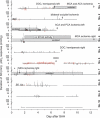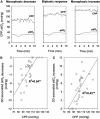Delayed cerebral ischemia and spreading depolarization in absence of angiographic vasospasm after subarachnoid hemorrhage
- PMID: 22146193
- PMCID: PMC3272613
- DOI: 10.1038/jcbfm.2011.169
Delayed cerebral ischemia and spreading depolarization in absence of angiographic vasospasm after subarachnoid hemorrhage
Abstract
It has been hypothesized that vasospasm is the prime mechanism of delayed cerebral ischemia (DCI) after aneurysmal subarachnoid hemorrhage (aSAH). Recently, it was found that clusters of spreading depolarizations (SDs) are associated with DCI. Surgical placement of nicardipine prolonged-release implants (NPRIs) was shown to strongly attenuate vasospasm. In the present study, we tested whether SDs and DCI are abolished when vasospasm is reduced or abolished by NPRIs. After aneurysm clipping, 10 NPRIs were placed next to the proximal intracranial vessels. The SDs were recorded using a subdural electrode strip. Proximal vasospasm was assessed by digital subtraction angiography (DSA). 534 SDs were recorded in 10 of 13 patients (77%). Digital subtraction angiography revealed no vasospasm in 8 of 13 patients (62%) and only mild or moderate vasospasm in the remaining. Five patients developed DCI associated with clusters of SD despite the absence of angiographic vasospasm in three of those patients. The number of SDs correlated significantly with the development of DCI. This may explain why reduction of angiographic vasospasm alone has not been sufficient to improve outcome in some clinical studies.
Figures




Comment in
-
Cortical spreading ischemia in the absence of proximal vasospasm after aneurysmal subarachnoid hemorrhage: evidence for a dual mechanism of delayed cerebral ischemia.J Cereb Blood Flow Metab. 2012 Feb;32(2):201-2. doi: 10.1038/jcbfm.2011.170. Epub 2011 Dec 7. J Cereb Blood Flow Metab. 2012. PMID: 22146191 Free PMC article.
References
-
- Abdelmoneim SS, Wijdicks EF, Lee VH, Daugherty WP, Bernier M, Oh JK, Pellikka PA, Mulvagh SL. Real-time myocardial perfusion contrast echocardiography and regional wall motion abnormalities after aneurysmal subarachnoid hemorrhage. Clinical article. J Neurosurg. 2009;111:1023–1028. - PubMed
-
- Adams HP, Jr, del Zoppo G, Alberts MJ, Bhatt DL, Brass L, Furlan A, Grubb RL, Higashida RT, Jauch EC, Kidwell C, Lyden PD, Morgenstern LB, Qureshi AI, Rosenwasser RH, Scott PA, Wijdicks EF. Guidelines for the early management of adults with ischemic stroke: a guideline from the American Heart Association/American Stroke Association Stroke Council, Clinical Cardiology Council, Cardiovascular Radiology and Intervention Council, and the Atherosclerotic Peripheral Vascular Disease and Quality of Care Outcomes in Research Interdisciplinary Working Groups: The American Academy of Neurology affirms the value of this guideline as an educational tool for neurologists. Circulation. 2007;115:478–534. - PubMed
-
- Barth M, Capelle HH, Weidauer S, Weiss C, Munch E, Thome C, Luecke T, Schmiedek P, Kasuya H, Vajkoczy P. Effect of nicardipine prolonged-release implants on cerebral vasospasm and clinical outcome after severe aneurysmal subarachnoid hemorrhage: a prospective, randomized, double-blind phase IIa study. Stroke. 2007;38:330–336. - PubMed
-
- Barth M, Woitzik J, Weiss C, Muench E, Diepers M, Schmiedek P, Kasuya H, Vajkoczy P. Correlation of clinical outcome with pressure-, oxygen-, and flow-related indices of cerebrovascular reactivity in patients following aneurysmal SAH. Neurocrit Care. 2010;12:234–243. - PubMed
Publication types
MeSH terms
Substances
LinkOut - more resources
Full Text Sources
Other Literature Sources
Medical

